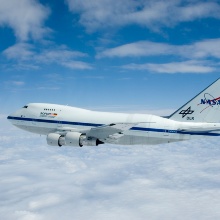For eight and a half years, the Stratospheric Observatory for Infrared Astronomy SOFIA explored space and enabled numerous scientific discoveries. After the U.S. space agency NASA and the German Space Agency at DLR announced on April 28, 2022, that they would cease operations using SOFIA, it has now found a new permanent home: the Pima Air & Space Museum in Tucson, Arizona in the USA. The German SOFIA Institute (DSI) at the University of Stuttgart, which has been the German point of contact responsible for the preparation and implementation of the scientific operation of SOFIA since 2004, will support its colleagues at NASA and the Pima Museum in integrating SOFIA into the permanent exhibition on site. It is still unclear when it will be on display for the public.
The telescope's main mirror is to be exhibited in Jena
By early December 2022, the DSI had already removed German hardware components such as the telescope's secondary mirror and the Focal Plane Imager plus (FPI+) and the observatory's guiding camera, on site at NASA Armstrong Flight Research Center in Palmdale, California, where SOFIA was previously stationed, and prepared them for shipment to Germany. In Tucson, colleagues at DSI will now remove the 2.7-meter-diameter primary mirror from the telescope, and this will then be transferred to the German Optical Museum (DOM) in Jena, where it will be the centerpiece of the new SOFIA exhibition at the DOM. The museum and exhibition are scheduled to open in 2026.
Preparations for returning the University of Stuttgart's imaging far-infrared spectrometer FIFI-LS (Field-Imaging Far-Infrared Line Spectrometer) to Stuttgart began in October 2022. How this particular instrument might be used in the future has not yet been decided. Its sensors, which were handcrafted specifically to detect far-infrared wavelengths, will definitely be preserved for possible future far-infrared missions.
- "Public relations for SOFIA is my dream job."
Interview with Dr. Dörte Mehlert
Observation data stored in the archives
All the observational data collected by SOFIA will go into the Infrared Science Archive (IRSA) at the Infrared Processing and Analysis Center (IPAC) in Pasadena, California, so that researchers can continue to gain scientific knowledge from it in the future. In the coming months, the DSI plans to set up a mirrored archive on a German server. "A great deal can still be gained from the archived data, so there will still be numerous new publications in the coming years," says Dr. Dörte Mehlert, who is responsible for education and public relations at the DSI.
Highlights of the flying observatory SOFIA
- May 26, 2010: First Light Flight [DE]: SOFIA takes to the skies and the telescope takes the first in-flight images. This demonstrated that the observatory was working.
- June 2, 2014: SOFIA achieves full operational status. This officially concludes the test phase for the observatory from 2007 to 2014.
- September 19 until 21, 2011: SOFIA visits Stuttgart Airport [DE]. Tours of the observatory are quickly sold out and there is a lot of media interest.
- May 2016: SOFIA detects atomic oxygen [DE] in Mars' atmosphere. Researchers have not been able to do this for 40 years.
- April 2019: With SOFIA, researchers successfully detect the helium hydride ion for the first time [DE]. This was the very first type of molecule in the universe.
- September 16 until 20, 2019: SOFIA visits Stuttgart Airport for the second time. And receives a huge amount of public and media interest.
- October 2020: SOFIA discovers molecular water on the Moon, creating a new water supply prospect for future space missions.
- April 2021: Thanks to data collected by SOFIA, scientists are able to determine the concentration of atomic oxygen in the Earth's atmosphere [DE] using high-resolution spectral measurements. This aids a better understanding of the atmosphere of our home planet.
- September 28, 2022: SOFIA completes its final science flight on the night of September 28 until 29, 2022



